Create and edit columns in Dataverse using Power Apps
Power Apps (make.powerapps.com) provides an easy way to create and edit table columns in Dataverse.
Power Apps enables configuring the most common options, but certain options can only be set using solution explorer.
More information:
- Create and edit columns for Dataverse
- Create and edit columns for Dataverse using Power Apps solution explorer
View columns
- From the Power Apps portal, select Tables and select the table that has the columns you want to view. If the item isn’t in the side panel pane, select …More and then select the item you want.
- With the Columns area selected, you can select the following views:
| View | Description |
|---|---|
| All | Shows all the columns for the table |
| Managed | Shows only managed and standard columns for the table |
| Custom | Shows only custom columns for the table |
| Default | Shows only the standard columns for the table |
Create a column
While viewing columns, in the command bar, select Add column which will show the Column properties panel.
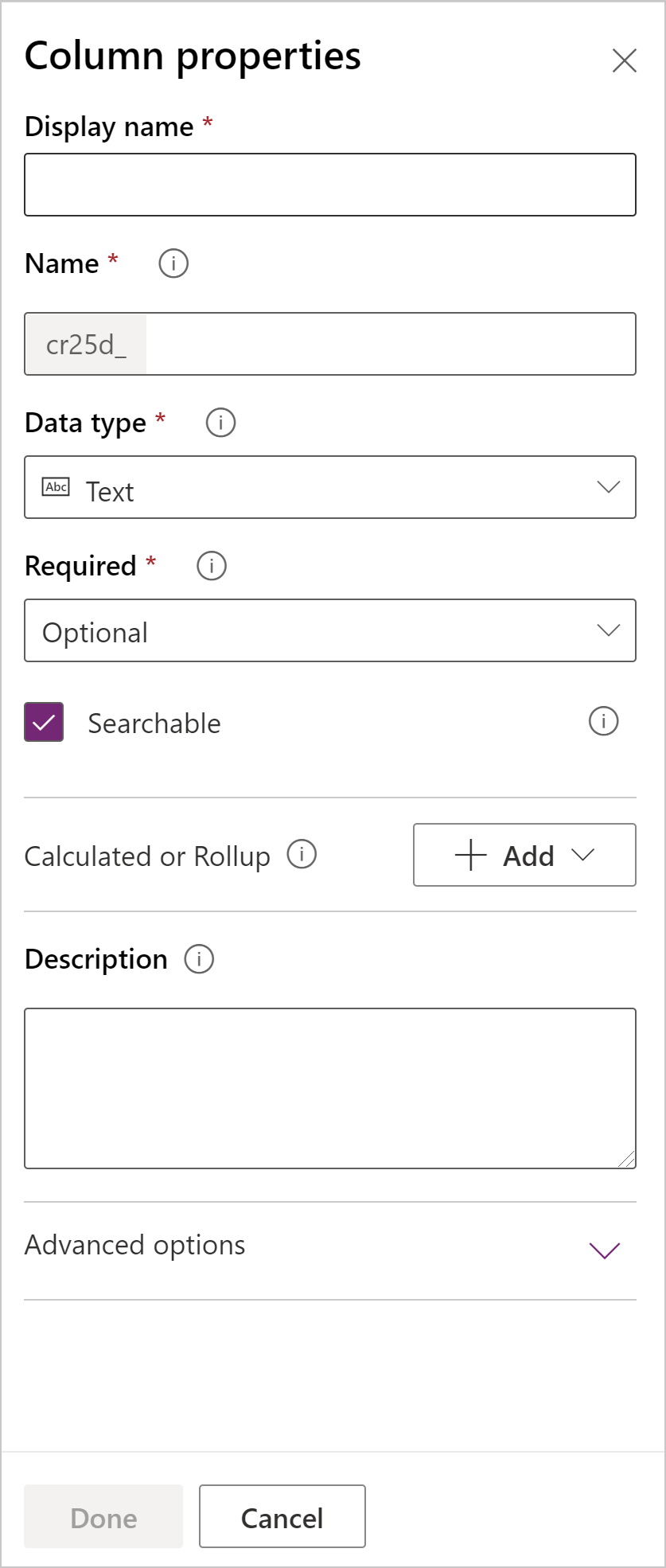
Initially, just three column properties are available:
| Property | Description |
|---|---|
| Display Name | The text to be displayed for the column in the user interface. |
| Name | The unique name across your environment. A name will be generated for you based on the display name that you've entered, but you can edit it before saving. Once a column is created the name cannot be changed as it may be referenced in your applications or code. The name will have the customization prefix for your Dataverse Default Publisher prepended to it. |
| Data type | Controls how values are stored as well as how they are formatted in some applications. Once a column is saved, you cannot change the data type with the exception of converting text columns to autonumber columns. |
| Required | A record can't be saved without data in this column. Notice that required columns on a hidden tab or section don’t block saving the record unless the same column is also in a visible tab or section on the same form. More information: Saving rows programmatically for required columns |
| Searchable | This column appears in Advanced Find and is available when customizing views. |
| Calculated or Rollup | Use to automate manual calculations. Use values, dates, or text. |
| Advanced Options | Add a description, and specify a maximum length and IME mode for the column. |
You can set additional options depending on your choice of Data type.
Column data types
There are many different types of columns, but you can only create some of them. For more information about all types of columns, see Types of columns and column data types.
When creating a column, Data type provides the following choices:
Text
Standard text columns can store up to 4,000 characters. The default Max Length option is set to a lower value you can adjust.
| Data type | Description |
|---|---|
| Text | A text value intended to be displayed in a single-line textbox. |
| Text Area | A text value intended to be displayed in a multi-line textbox. If you require more than 4,000 characters, use a Multiline Text data type. |
| A text value validated as an e-mail address and rendered as a mailto link in the column. | |
| URL | A text value validated as a URL and rendered as a link to open the URL. |
| Ticker Symbol | A text value for a ticker symbol that will display a link that will open to show a quote for the stock ticker symbol. |
| Phone | A text value validated as a phone number rendered as link to initiate a phone call by using Skype. |
| Autonumber | A customizable combination of numbers and letters that is automatically generated by the server whenever the row is created. More information: Autonumber columns |
Max Length
Columns that store text have an absolute maximum depending on the type. The Max Length choices a value lower than the maximum specific to your environment. You can increase this max length but you should not lower it if you have data in the system that exceeds the lower value.
Whole Number
These columns store data as a number but include different presentation and validation options.
| Format | Description |
|---|---|
| Duration | A number value presented as a drop-down list that contains time intervals. A user can select a pre-defined value from the list or type an integer value using the format: “x minutes”, “x hours” or “x days”. Hours and days can be entered using decimals, for example, “1.2 hours” or “1.5 days”. Minute values entered must be expressible in whole minutes. Entering a decimal to represent sub-minute values will be rounded to the nearest minute. 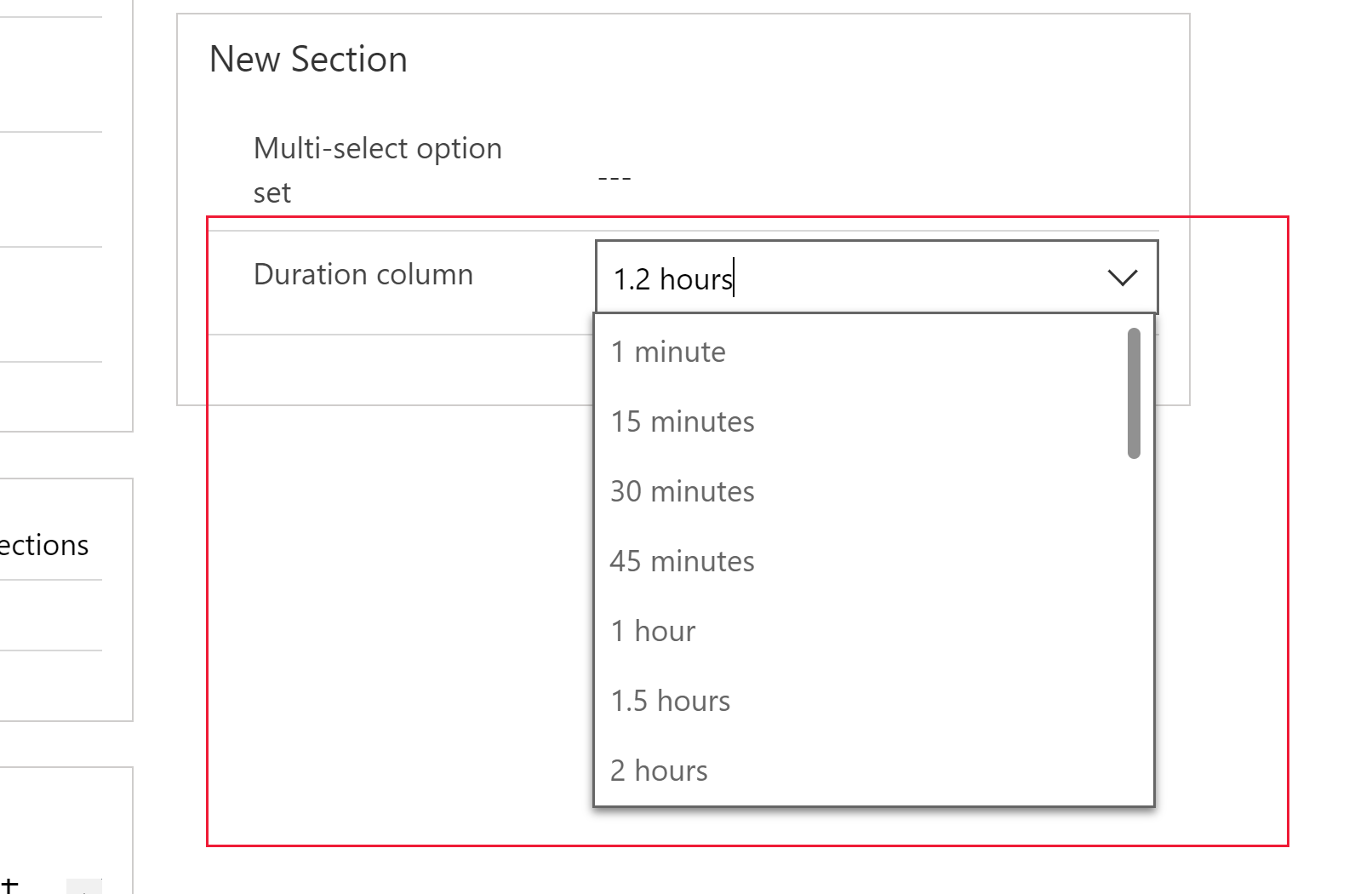 |
| Timezone | A number value presented as a drop-down list that contains a list of time zones. |
| Language code | A number value presented as a drop-down list that contains a list of languages that have been enabled for the environment. If no other languages have been enabled, the base language will be the only option. The value saved is the Locale Identifier (LCID) value for the language. |
| None | No special formatting will be applied for the whole number column. This is the default format. |
Date Time
Use these columns to store time values. You can store values as early as 1/1/1753 12:00 AM.
| Data type | Description |
|---|---|
| Date and Time | A date and time value. |
| Date Only | A date and time value that only displays a date. The time value is stored as 12:00 AM (00:00:00) in the system. |
You can also set specific Behavior for Date Time columns in the Advanced options.
- User local : Displays values converted to in the current user’s local time zone. This is the default for new columns.
- Date only: This behavior is available for the Date Only type. Displays values without time zone conversion. Use this for data like birthdays and anniversaries.
- Time zone independent: Displays values without time zone conversion.
More information: Behavior and format of the Date and Time column
Other Data types
| Data type | Description |
|---|---|
| Currency | A money value for any currencies configured for the environment. You can set a level of precision or choose to base the precision on a specific currency or a single standard precision used by the organization. More information: Using currency columns |
| Decimal Number | A decimal value with up to 10 points of precision. More information: Using the right type of number |
| File | For storing binary data. |
| Floating Point Number | A floating point number with up to 5 points of precision. More information: Using the right type of number |
| Image | Displays a single image per row in the application. Each table can have one image column. The Name you enter when creating an image column will be ignored. Image columns are always named 'tableImage'. |
| Lookup | Creates a reference to a single row for a single target row type. |
| Multi Select Choice | Displays a list of options where more than one can be selected. |
| Multiline Text | A text value intended to be displayed in a multi-line textbox. Limited to a maximum of 1,048,576 characters. You can also set a lower Max Length. |
| Choice | Displays a list of options where only one can be selected. |
| Yes/No | Displays Yes/No where only one can be selected. You choose which labels are displayed for each option. The default values are Yes and No. |
Save new column
Once you have set the Display Name, Name and Data type properties you can select Done to close the Column properties panel.
You can continue to edit the table and add additional columns or return and continue editing this column. The columns will not be created until you select Save Table to save all the changes to the table.

You can also select Discard to discard the changes you have made.
Edit a column
While viewing columns, select the column you want to edit. You can modify the Display Name but you cannot change the Name and Data type if you have saved changes to the table to add the column.
General properties
Every column has the following properties you can change:
| Property | Description |
|---|---|
| Required | When this is selected a row can't be saved without data in this column. More information: Saving rows programmatically for required columns |
| Searchable | De-select this for columns for the table that you don’t use. When a column is searchable it appears in Advanced Find and is available when customizing views. De-selecting this will reduce the number of options shown to people using advanced find. |
| Description | Found within Advanced Options. Enter instructions to the user about what the column is for. These descriptions appear as tooltips for the user in model-driven apps when they hover their mouse over the label of the column. |
Note
Making columns required: Be careful when you make columns required. People will resist using the application if they can’t save rows because they lack the correct information to enter into a required column. People may enter incorrect data simply to save the row and get on with their work.
Set requirement dynamically: In model-driven apps you can use business rules or form scripts to change the requirement level as the data in the row changes as people work on it. More information: Create business rules and recommendations to apply logic in a form
Advanced Find availability: Advanced Find is currently only available for model-driven apps using the Web Client. Advanced find is not currently available in Unified Interface clients.
Searching and sorting columns
For information about columns that can't be enabled for searching or sorting, go to Searching and sorting columns.
Saving rows programmatically for required columns
When a row is saved programmatically using web services, only the SystemRequired columns are enforced. Failure to set a value for SystemRequired columns will return an error. You can’t set the SystemRequired level of requirement.
Setting a column to Business Required means that the default behavior of a model-driven or canvas app will enforce this requirement in the app. The request will not be sent to the service if the column has no value. The app user is shown an error and prompted to add data to the required column before they can save the row. There are options within the app to override this behavior and allow operation to proceed if needed.
Calculated or Rollup
You can set a custom column to be a Calculated or a Rollup column. Columns that are not calculated or rollup columns are sometimes referred to as simple columns.
Calculated
With a calculated column you can enter a formula to assign a value to the column. These data types can be set to calculated columns: Currency, Date and Time, Date Only, Decimal Number, Duration, Email, Language, Multi Select Option Set, Choice, Text, Text Area, Ticker Symbol, Timezone, Two Options, URL, and Whole Number.
More information: Define calculated columns to automate manual calculations
Rollup
With a rollup column you can set aggregation functions that will run periodically to set a number value for the column. These data types can be set to calculated columns: Currency, Date and Time, Date Only, Decimal Number, Duration, Language, Timezone, and Whole Number.
More information: Define rollup columns that aggregate values
Number column options
Each type of number column has absolute minimum and maximum values. You can set appropriate Minimum value and Maximum value within these absolute values. Do this to have Dataverse validate the values for the data you want to store in the column.
For Floating Point Number and Decimal Number data types, you can specify a number of Decimal places.
Choice column options
Columns that provide a set of options can include their own set of local options or refer to a common set of global options that can be used by multiple columns.
Using a global choice is valuable when you find yourself creating the same set of options for multiple columns. With a global choice , you only need to maintain the set of options in one place.
When you choose Multi Select Choice or Choice data type the designer will list a set of available global choices for you to choose from and provide the option to create a New choice.
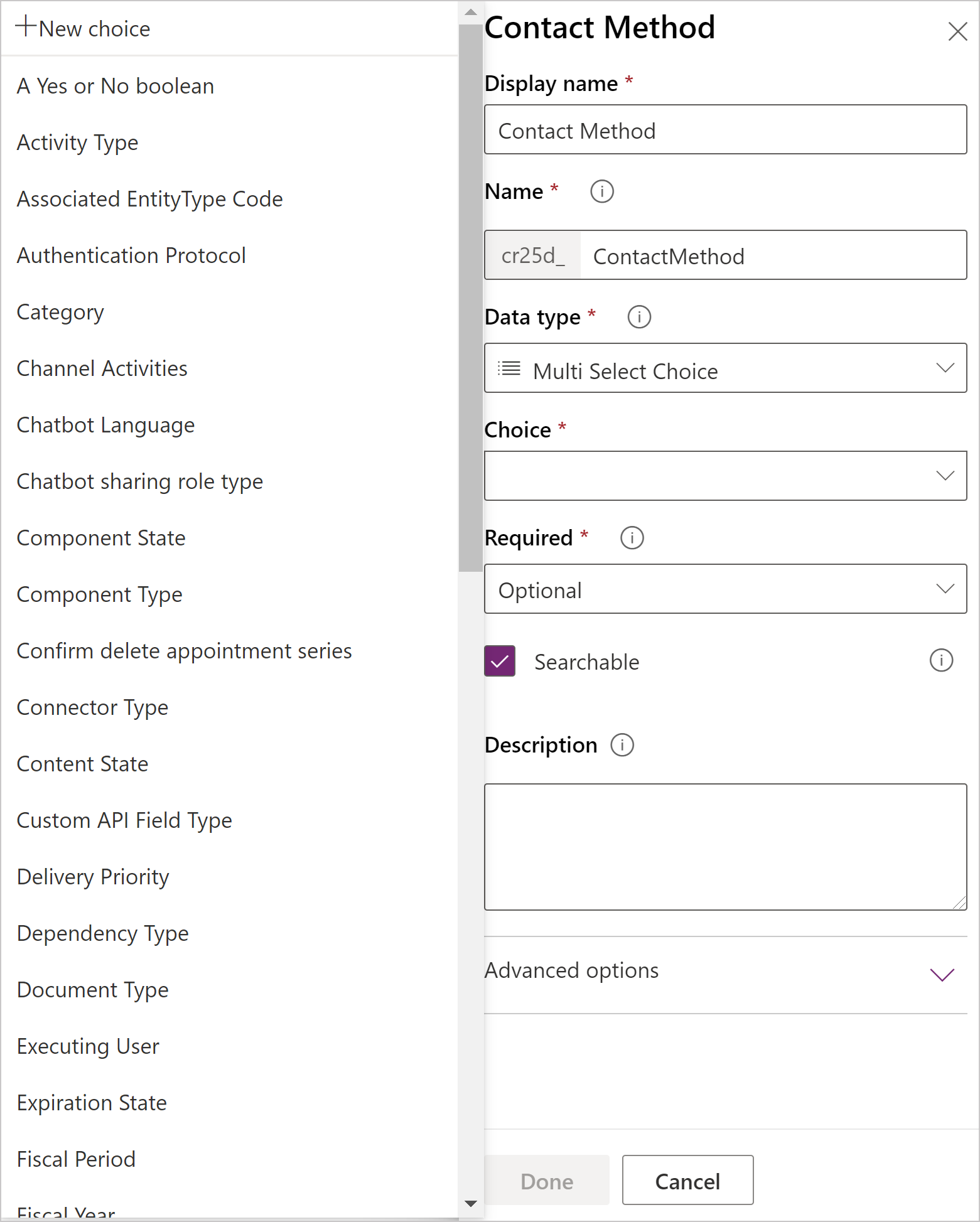
If you choose New choice the default behavior is to create a new global choice.
Note
While you are editing options for a new global choice, the Display name and Name values are for the global choice rather than for the column. The default values match the column values, but you can edit them while you edit the global choice to be different from the column you are currently creating.
If you want to create a local choice you must select View more and choose Local choice.
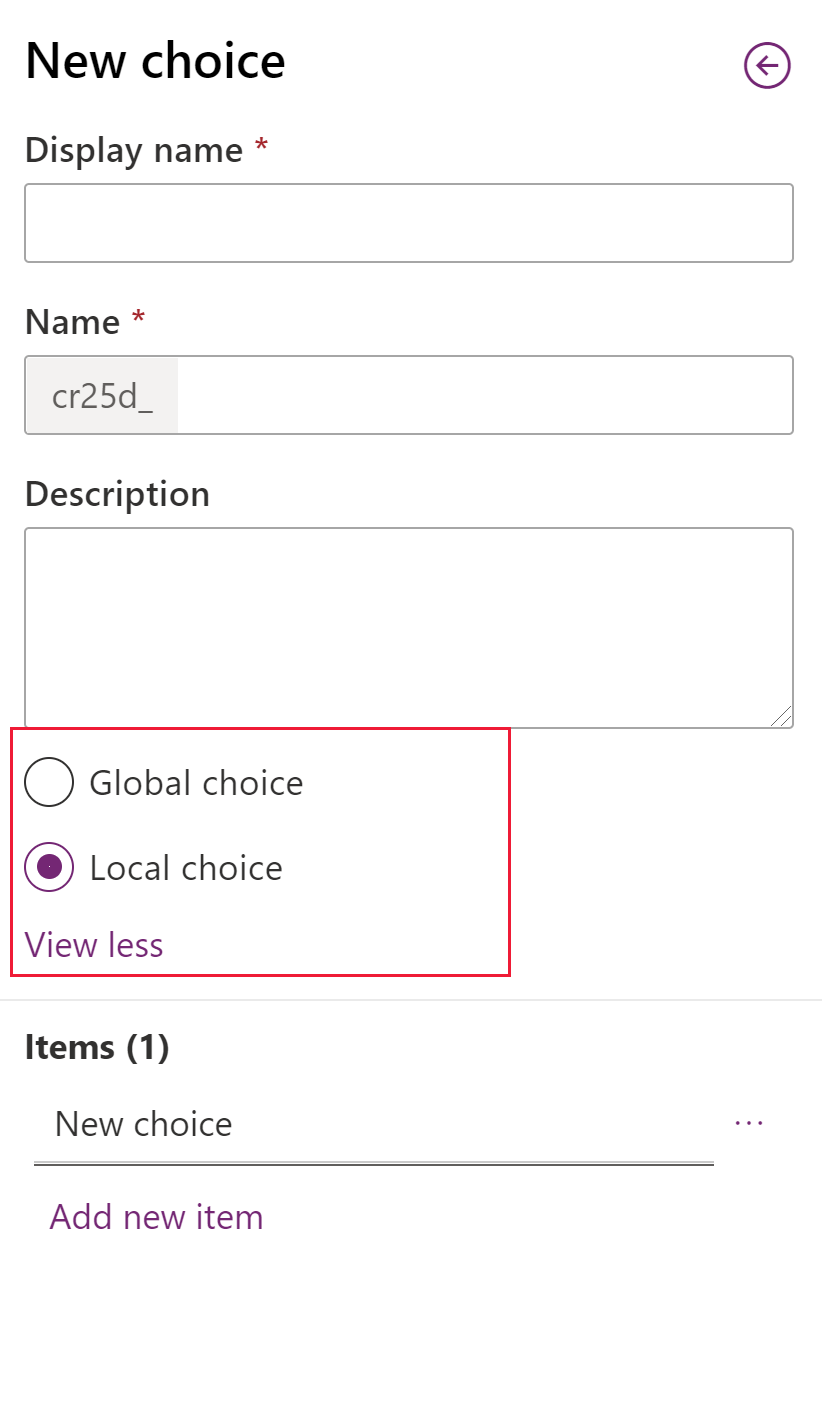
Note
If you define every choice as a global choice your list of global choices will grow and could be difficult to manage. If you know that the set of options will only be used in one place, use a local choice.
Warning
If you remove an option which has been used by an entity record the data for that record will become invalid after you save your changes to the global option set.
Before you remove an option that has been used, you should change the data in any entity record that uses that option to a valid value.
Delete a column
With the system administrator security role, you can delete any custom columns that aren’t part of a managed solution. When you delete a column, any data stored in the column is lost. The only way to recover data from a column that was deleted is to restore the database from a point before the column was deleted.
Note
Before you can delete a custom column, you must remove any dependencies that may exist in other solution components.
While viewing columns, if you select a custom column that can be deleted in the list, the Delete column command appears and is enabled.
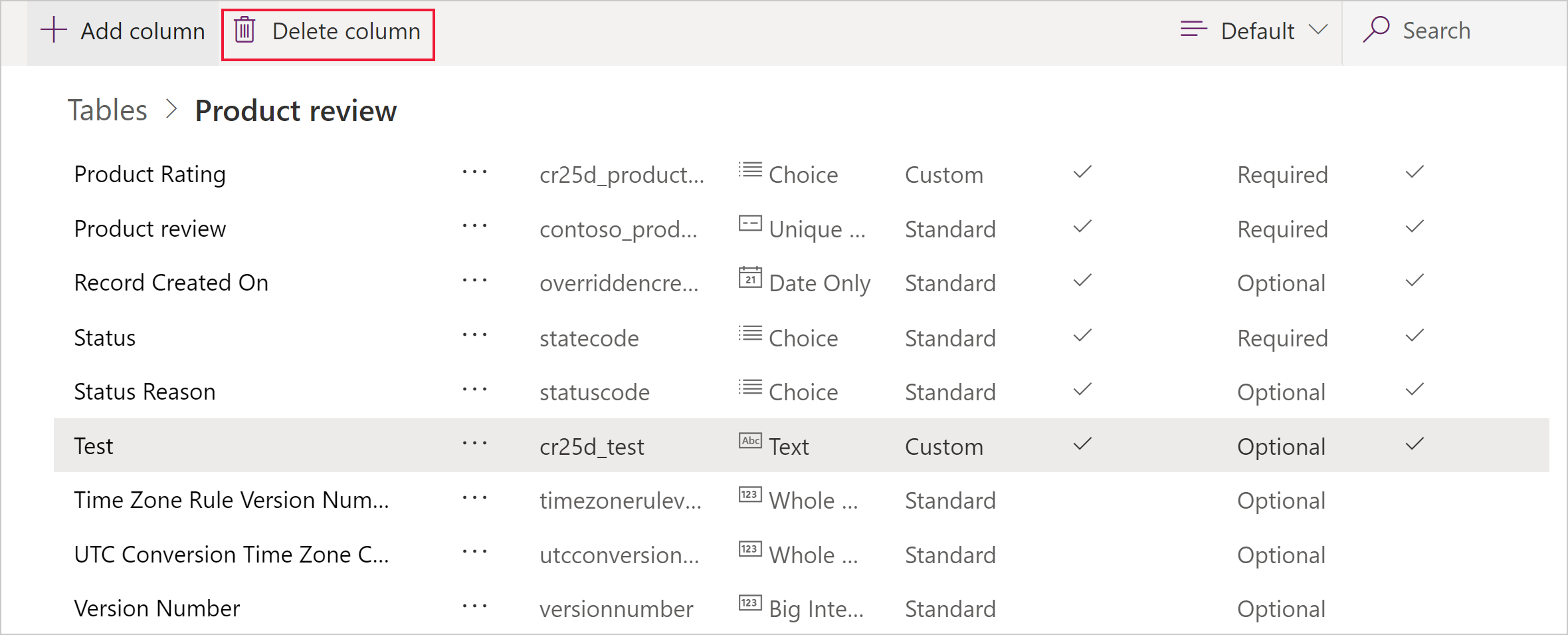
Use the Delete column command to delete the column. After deleting the column you must save the changes to the table.
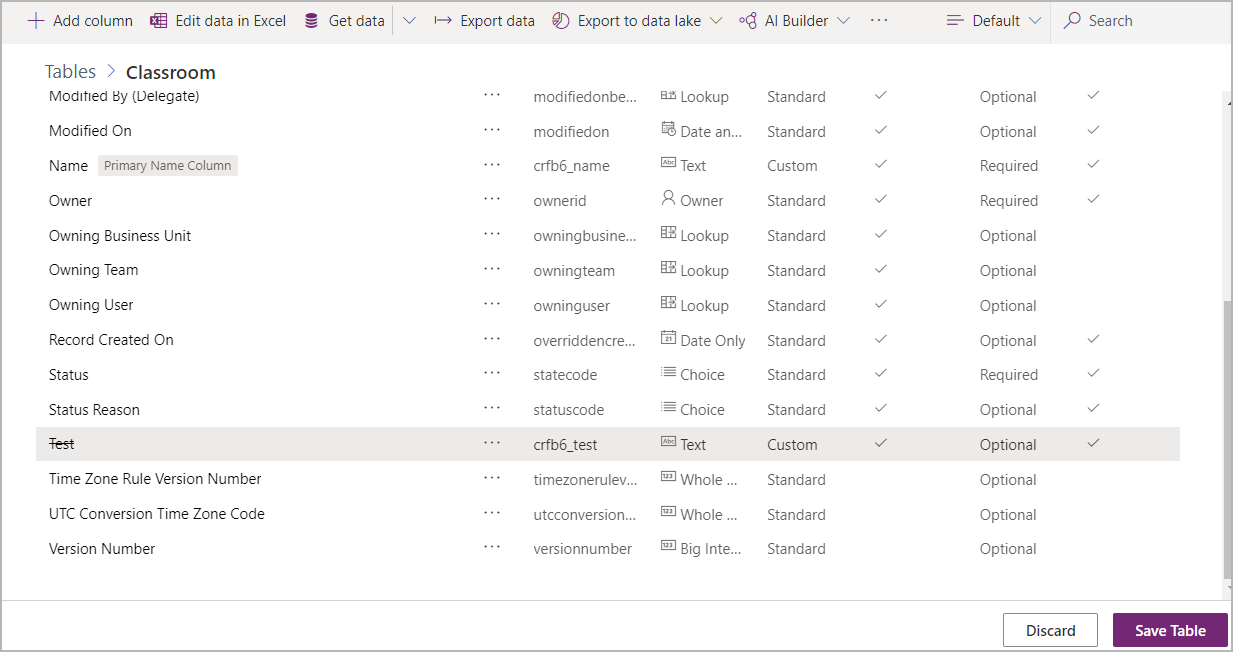
Note
If you get an error related to dependencies, you must use solution explorer to detect dependencies. More information: Check column dependencies
IME Mode
IME (input method editor) mode specifies how a physical keyboard can be used to enter characters for text columns. IMEs are tools provided by the operating system for composing text. They are commonly used to enter Chinese, Japanese, and Korean words. IME mode does not restrict the characters that users can enter. For example, when IME mode is disabled, users can still enter Japanese characters by pasting in a text input.
Important
IME Mode is used for backward compatibility with the legacy web client and the IME Mode settings described here don’t apply to Unified Interface apps. Additionally, IME mode is supported only in Internet Explorer and partially supported in Firefox.
- Active: This value will activate the IME initially. You can deactivate it later if desired. This is the default IME setting.
- Auto: When IME mode is auto, Power Apps will not interfere with the IME.
- Disabled: Disable IME mode to bypass the IME. This can be useful for entering alphanumeric characters in certain languages.
- Inactive: Power Apps will deactivate the IME initially. You can activate it later if desired.
See also
Create and edit columns for Dataverse
Create and edit columns for Dataverse using Power Apps solution explorer
Types of columns and column data types
Define calculated columns to automate manual calculations
Define rollup columns that aggregate values
Behavior and format of the Date and Time column
Feedback
Coming soon: Throughout 2024 we will be phasing out GitHub Issues as the feedback mechanism for content and replacing it with a new feedback system. For more information see: https://aka.ms/ContentUserFeedback.
Submit and view feedback for